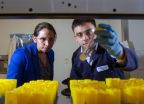(Press-News.org) EAST LANSING, MI--Since the introduction of 'Honeycrisp' apples in 1991, the variety has become a consumer favorite for its unusual texture and delicious flavor. Honeycrisp has increased in popularity with growers as well; Michigan, New York, and Washington boast significant numbers of 'Honeycrisp' orchards. As the growing area dedicated to the variety has grown, the need to find better methods for improving storage performance has become more important to growers. Because 'Honeycrisp' is very sensitive to low temperatures and can be damaged by controlled-atmosphere conditions, long-term storage of the apples can be challenging.
Carolina Contreras and Randy Beaudry from the Department of Horticulture at Michigan State University and Nihad Alsmairat from the Department of Horticulture and Crop Science at the University of Jordan published a study in HortScience that revealed some important information for apple producers. "Our work was conducted in two phases," Beaudry explained. "The first phase was designed to determine whether 'Honeycrisp' apples were susceptible to controlled-atmosphere injury, to determine the relative influence of O2 and CO2, and to identify a treatment combination that would reliably generate symptoms so that control measures could be subsequently evaluated." In the second phase, the scientists evaluated options for avoiding injury to 'Honeycrisp' during controlled-atmosphere storage. Fruit were conditioned at 3º C, 10º C, and 20º C for 5 days and then exposed to one of nine different storage treatments.
In the first experiment, 'Honeycrisp' exhibited a high sensitivity to both low oxygen and elevated CO2 levels. "We found that the controlled-atmospheres used induced injuries typical of those associated with CO2 (i.e., small brown lesions and associated lens-shaped cavities) and also larger dark brown lesions with often irregular margins," the authors said. "The extent of the injury was higher for those fruit in an atmosphere with elevated CO2 for each level of O2."
Subsequent experiments took place over 3 years, during which the researchers reproduced the controlled-atmosphere (CA) injury from the preliminary study with varied intensity. Although the researchers observed high variability between orchards and years, they found two treatments that effectively controlled the CA injury. "We found that the brown lesions in the cortex were completely suppressed by DPA application, even when the prestorage conditioning temperature was 3º C," Beaudry said. "The incidence of cavities ranged from 0.1% to 0.3% under the same DPA treatment. On the other hand, the most affected treatment was 3/3 followed by 3/0, 21/0, and 21/ 0 plus 1-MCP."
The authors noted that, while there is good progress toward determining optimal storage recommendations for 'Honeycrisp' additional studies are still warranted. "For instance, although the 7-day prestorage conditioning treatments provided some protection against the development of CA injury, shorter durations should be investigated to prevent quality loss resulting from excessive ripening, which could cause increased skin greasiness and undesirable flavor profile."
The study includes additional recommendations for handling 'Honeycrisp' in prestorage conditions.
INFORMATION:
The complete study and abstract are available on the ASHS HortScience electronic journal web site: http://hortsci.ashspublications.org/content/49/1/76.abstract
Founded in 1903, the American Society for Horticultural Science (ASHS) is the largest organization dedicated to advancing all facets of horticultural research, education, and application. More information at ashs.org
Prestorage conditioning, diphenylamine improve condition of 'honeycrisp' apple
Scientists determine methods for improving resistance to controlled-atmosphere-related injury
2014-03-26
ELSE PRESS RELEASES FROM THIS DATE:
Nitrogen source determined significant for inflorescence development in Phalaenopsis
2014-03-26
TAIPEI, TAIWAN--The Phalaenopsis orchid, also known as the moth orchid, is the most important pot flower in terms of market value in the world's major floriculture markets. Because nitrogen significantly affects the growth and flowering of Phalaenopsis, nitrogen needs during flowering are of particular interest to growers. Researchers Hadi Susilo, Ying-Chun Peng, and Yao-Chien Alex Chang from the Department of Horticulture and Landscape Architecture at National Taiwan University published a study in the Journal of the American Society for Horticultural Science that determined ...
Engineered bacteria produce biofuel alternative for high-energy rocket fuel
2014-03-26
Researchers at the Georgia Institute of Technology and the Joint BioEnergy Institute have engineered a bacterium to synthesize pinene, a hydrocarbon produced by trees that could potentially replace high-energy fuels, such as JP-10, in missiles and other aerospace applications. With improvements in process efficiency, the biofuel could supplement limited supplies of petroleum-based JP-10, and might also facilitate development of a new generation of more powerful engines.
By inserting enzymes from trees into the bacterium, first author and Georgia Tech graduate student ...
Ancient sea creatures filtered food like modern whales
2014-03-26
The animals lived 520 million years ago during the Early Cambrian, a period known as the 'Cambrian Explosion' in which all the major animal groups and complex ecosystems suddenly appeared. Tamisiocaris belongs to a group of animals called anomalocarids, a type of early arthropod that included the largest and some of the most iconic animals of the Cambrian period. They swam using flaps down either side of the body and had large appendages in front of their mouths that they most likely used to capture larger prey, such as trilobites.
However, the newly discovered fossils ...
First ring system around asteroid
2014-03-26
The rings of Saturn are one of the most spectacular sights in the sky, and less prominent rings have also been found around the other giant planets. Despite many careful searches, no rings had been found around smaller objects orbiting the Sun in the Solar System. Now observations of the distant minor planet [1] (10199) Chariklo [2] as it passed in front of a star have shown that this object too is surrounded by two fine rings.
"We weren't looking for a ring and didn't think small bodies like Chariklo had them at all, so the discovery — and the amazing amountof detail ...
Gut metabolism changes -- not stomach size -- linked to success of vertical sleeve gastrectomy
2014-03-26
CINCINNATI—It's not the size of the stomach that causes weight loss after a specific type of bariatric surgery, but rather a change in the gut metabolism, say researchers from the University of Cincinnati (UC), the University of Gothenburg in Sweden and Cincinnati Children's Hospital Medical Center.
The scientists, publishing their results in the March 26, 2014, advanced online edition of Nature, have found that following vertical sleeve gastrectomy, there is a change in bile acids that bind to a nuclear receptor called FXR. In the absence of FXR, the researchers showed, ...
Some breast cancer tumors hijack patient epigenetic machinery to evade drug therapy
2014-03-26
PITTSBURGH, March 26, 2014 – A breast cancer therapy that blocks estrogen synthesis to activate cancer-killing genes sometimes loses its effectiveness because the cancer takes over epigenetic mechanisms, including permanent DNA modifications in the patient's tumor, once again allowing tumor growth, according to an international team headed by the University of Pittsburgh Cancer Institute (UPCI).
The finding warrants research into adding drugs that could prevent the cancer from hijacking patients' repressive gene regulatory machinery, which might allow the original therapy ...
First comprehensive atlas of human gene activity released
2014-03-26
Boston, MA — A large international consortium of researchers has produced the first comprehensive, detailed map of the way genes work across the major cells and tissues of the human body. The findings describe the complex networks that govern gene activity, and the new information could play a crucial role in identifying the genes involved with disease.
"Now, for the first time, we are able to pinpoint the regions of the genome that can be active in a disease and in normal activity, whether it's in a brain cell, the skin, in blood stem cells or in hair follicles," said ...
Brain degeneration in Huntington's disease caused by amino acid deficiency
2014-03-26
Working with genetically engineered mice, Johns Hopkins neuroscientists report they have identified what they believe is the cause of the vast disintegration of a part of the brain called the corpus striatum in rodents and people with Huntington's disease: loss of the ability to make the amino acid cysteine. They also found that disease progression slowed in mice that were fed a diet rich in cysteine, which is found in foods such as wheat germ and whey protein.
Their results suggest further investigation into cysteine supplementation as a candidate therapeutic in people ...
Cosmic collision creates mini-planet with rings
2014-03-26
Until now, rings of material in a disc have only been observed around giant planets like Jupiter, Uranus, Neptune and especially Saturn, which is known for its spectacular rings. Now astronomers from the Niels Bohr Institute, among others, have observed the first miniature planet with two rings of ice and pebbles. It is a smaller celestial body, called Chariklo, located two billion kilometers out in the solar system between Saturn and Uranus. The results are published in the prestigious scientific journal, Nature.
Chariklo was located in the Kuiper Belt, a collection ...
New maps for navigating the genome unveiled by scientists
2014-03-26
Scientists have built the clearest picture yet of how our genetic material is regulated in order to make the human body work.
They have mapped how a network of switches, built into our DNA, controls where and when our genes are turned on and off.
University of Edinburgh scientists played a leading role in the international project – called FANTOM5 – which has been examining how our genome holds the code for creating the fantastic diversity of cell types that make up a human.
The three year project, steered by the RIKEN Center for Life Science Technologies in Japan, ...
LAST 30 PRESS RELEASES:
University of Cincinnati experts present research at annual hematology event
ASH 2025: Antibody therapy eradicates traces of multiple myeloma in preliminary trial
ASH 2025: AI uncovers how DNA architecture failures trigger blood cancer
ASH 2025: New study shows that patients can safely receive stem cell transplants from mismatched, unrelated donors
Protective regimen allows successful stem cell transplant even without close genetic match between donor and recipient
Continuous and fixed-duration treatments result in similar outcomes for CLL
Measurable residual disease shows strong potential as an early indicator of survival in patients with acute myeloid leukemia
Chemotherapy and radiation are comparable as pre-transplant conditioning for patients with b-acute lymphoblastic leukemia who have no measurable residual disease
Roughly one-third of families with children being treated for leukemia struggle to pay living expenses
Quality improvement project results in increased screening and treatment for iron deficiency in pregnancy
IV iron improves survival, increases hemoglobin in hospitalized patients with iron-deficiency anemia and an acute infection
Black patients with acute myeloid leukemia are younger at diagnosis and experience poorer survival outcomes than White patients
Emergency departments fall short on delivering timely treatment for sickle cell pain
Study shows no clear evidence of harm from hydroxyurea use during pregnancy
Long-term outlook is positive for most after hematopoietic cell transplant for sickle cell disease
Study offers real-world data on commercial implementation of gene therapies for sickle cell disease and beta thalassemia
Early results suggest exa-cel gene therapy works well in children
NTIDE: Disability employment holds steady after data hiatus
Social lives of viruses affect antiviral resistance
Dose of psilocybin, dash of rabies point to treatment for depression
Helping health care providers navigate social, political, and legal barriers to patient care
Barrow Neurological Institute, University of Calgary study urges “major change” to migraine treatment in Emergency Departments
Using smartphones to improve disaster search and rescue
Robust new photocatalyst paves the way for cleaner hydrogen peroxide production and greener chemical manufacturing
Ultrafast material captures toxic PFAS at record speed and capacity
Plant phenolic acids supercharge old antibiotics against multidrug resistant E. coli
UNC-Chapel Hill study shows AI can dramatically speed up digitizing natural history collections
OYE Therapeutics closes $5M convertible note round, advancing toward clinical development
Membrane ‘neighborhood’ helps transporter protein regulate cell signaling
Naval aviator turned NPS doctoral student earns national recognition for applied quantum research
[Press-News.org] Prestorage conditioning, diphenylamine improve condition of 'honeycrisp' appleScientists determine methods for improving resistance to controlled-atmosphere-related injury




